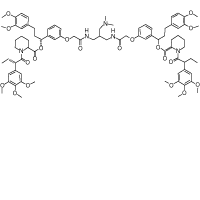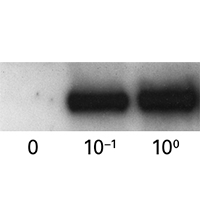Ligands for chemically induced dimerization (CID)

These small-molecule ligands for use with iDimerize Systems are supplied either lyophilized or prealiquoted in ethanol. More information on each ligand can be viewed by clicking the "more" button.
These small-molecule ligands for use with iDimerize Systems are supplied either lyophilized or prealiquoted in ethanol. More information on each ligand can be viewed by clicking the "more" button.
B/B Homodimerizer (identical to AP20187)
The B/B Homodimerizer (AP20187) is a synthetic, cell-permeable ligand that can be used to induce homodimerization of fusion proteins containing the DmrB domain. The B/B Homodimerizer has been tested in vitro and in mice. It is nontoxic. We suggest testing various B/B Homodimerizer concentrations within the recommended range (0.01–100 nM for in vitro use or 0.005–10 mg/kg in mice) in order to obtain a complete dose-response profile. This homodimerizer has been widely used to study signal transduction pathways (by inducing oligomerization of cell surface receptor proteins), but it can be used to induce the activity/re-localization of any protein that is affected by oligomerization. The B/B Homodimerizer is identical to the AP20187 ligand, which was previously supplied by ARIAD Pharmaceuticals, Inc.
B/B Washout Ligand (for use with the iDimerize Inducible Homodimer Systems)
B/B Washout Ligand is a membrane-permeant ligand that dissociates protein interactions induced by the B/B Homodimerizer (t1/2 of ~10 minutes after adding it to target cells treated with B/B Homodimerizer).
A/C Heterodimerizer (identical to AP21967)
The A/C Heterodimerizer (AP21967) is a cell-permeable ligand used to induce heterodimerization of two different fusion proteins containing the DmrA and DmrC domains, respectively. The A/C Heterodimerizer has been tested in vitro and in mice. It is nontoxic to cells at up to 1 µM concentrations and in mice at up to 30 mg/kg. We suggest testing various A/C Heterodimerizer concentrations within the recommended range (0.05 nM–500 nM for in vitro use) in order to obtain a complete dose-response profile. The A/C Heterodimerizer is identical to the AP21967 ligand, which was previously supplied by ARIAD Pharmaceuticals, Inc.
D/D Solubilizer (functionally equivalent to AP21998)
The D/D Solubilizer is a synthetic, cell-permeable ligand that can be used with the iDimerize Reverse Dimerization System to disrupt oligomerization of fusion proteins containing the DmrD domain. This ligand has been tested in vitro and in mice for applications including inducible secretion of proteins. It is nontoxic. We suggest testing various D/D Solubilizer concentrations within the recommended range (10–500 nM) for different lengths of time (30 minutes to 12+ hours) in order to obtain a complete dose-response profile. The D/D Solubilizer performs the same function as the AP21998 ligand, which was previously supplied by ARIAD Pharmaceuticals, Inc. It is a different molecule than AP21998.
Overview
- Small molecules used for chemical-induced dimerization (CID).
- B/B Homodimerizer is identical to AP20187 and used with inducible homodimerization systems.
- A/C Heterodimerizer is identical to AP21967 and used with inducible heterodimerization systems.
- The D/D Solubilizer, used with reverse dimerization systems, performs the same function as the AP21998 ligand, which was previously supplied by ARIAD Pharmaceuticals Inc.; however, it is a different molecule than AP21998.
- B/B Washout Ligand disrupts protein interactions that were induced by the B/B Homodimerizer.
More Information
Applications
- Used to activate pathways or events that are controlled by protein-protein interactions
Additional product information
Please see the product's Certificate of Analysis for information about storage conditions, product components, and technical specifications. Please see the Kit Components List to determine kit components. Certificates of Analysis and Kit Components Lists are located under the Documents tab.
Takara Bio USA, Inc.
United States/Canada: +1.800.662.2566 • Asia Pacific: +1.650.919.7300 • Europe: +33.(0)1.3904.6880 • Japan: +81.(0)77.565.6999
FOR RESEARCH USE ONLY. NOT FOR USE IN DIAGNOSTIC PROCEDURES. © 2025 Takara Bio Inc. All Rights Reserved. All trademarks are the property of Takara Bio Inc. or its affiliate(s) in the U.S. and/or other countries or their respective owners. Certain trademarks may not be registered in all jurisdictions. Additional product, intellectual property, and restricted use information is available at takarabio.com.





